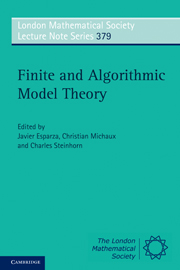Book contents
- Frontmatter
- Contents
- Preface
- 1 Automata-based presentations of infinite structures
- 2 Logical aspects of spatial databases
- 3 Some connections between finite and infinite model theory
- 4 Definability in classes of finite structures
- 5 Algorithmic meta-theorems
- 6 Model theoretic methods for fragments of FO and special classes of (finite) structures
- Bibliography
1 - Automata-based presentations of infinite structures
Published online by Cambridge University Press: 01 June 2011
- Frontmatter
- Contents
- Preface
- 1 Automata-based presentations of infinite structures
- 2 Logical aspects of spatial databases
- 3 Some connections between finite and infinite model theory
- 4 Definability in classes of finite structures
- 5 Algorithmic meta-theorems
- 6 Model theoretic methods for fragments of FO and special classes of (finite) structures
- Bibliography
Summary
Finite presentations of infinite structures
The model theory of finite structures is intimately connected to various fields in computer science, including complexity theory, databases, and verification. In particular, there is a close relationship between complexity classes and the expressive power of logical languages, as witnessed by the fundamental theorems of descriptive complexity theory, such as Fagin's Theorem and the Immerman-Vardi Theorem (see [78, Chapter 3] for a survey).
However, for many applications, the strict limitation to finite structures has turned out to be too restrictive, and there have been considerable efforts to extend the relevant logical and algorithmic methodologies from finite structures to suitable classes of infinite ones. In particular this is the case for databases and verification where infinite structures are of crucial importance [130]. Algorithmic model theory aims to extend in a systematic fashion the approach and methods of finite model theory, and its interactions with computer science, from finite structures to finitely-presentable infinite ones.
There are many possibilities to present infinite structures in a finite manner. A classical approach in model theory concerns the class of computable structures; these are countable structures, on the domain of natural numbers, say, with a finite collection of computable functions and relations. Such structures can be finitely presented by a collection of algorithms, and they have been intensively studied in model theory since the 1960s. However, from the point of view of algorithmic model theory the class of computable structures is problematic.
- Type
- Chapter
- Information
- Finite and Algorithmic Model Theory , pp. 1 - 76Publisher: Cambridge University PressPrint publication year: 2011
- 7
- Cited by

